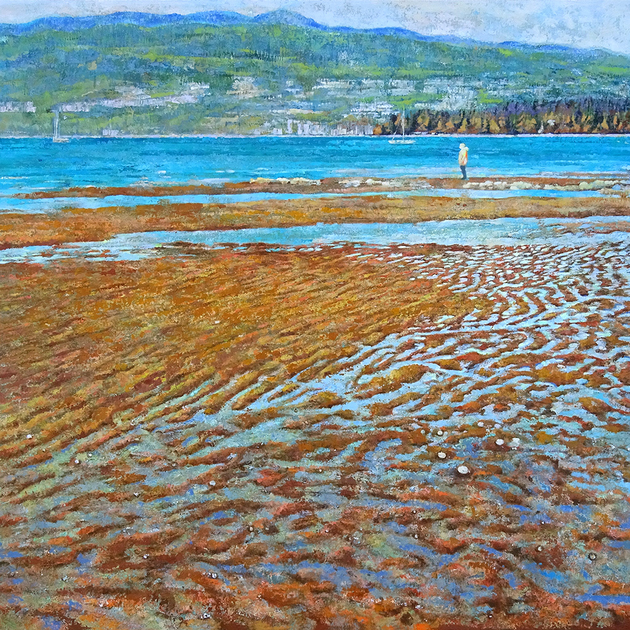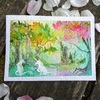Spotlight Artist Elizabeth Malara-Wieczorek

Thalo loves to promote artists and each month we spotlight a member of our community!
This month we are pleased to have Elizabeth Malara-Wieczorek as the thalo Spotlight Artist for February 2020!
Thalo Team: Can you give an “elevator pitch” of your work?
Elizabeth Malara-Wieczorek: I look for opportunities to build bonds with art lovers. Art is a language that connects people. It lets us express emotions, share experiences, knowledge, and feelings — to reflect in front of a piece of work. The discovery of a community of joy and thoughts can be valuable and rewarding in our mutual relationships and understanding.
TT: What is your artwork about, and what do you want people to take from it?
EMW: Art as an Artwork, Art as an Action, and Art as an Interaction, in every aspect, are an excellent way to experience the beauty that our lives offers us. I strive to make it visible for others.
TT: Which artists do you feel have influenced your art the most?
EMW: The most significant influence in my formative years was Jan Matejko, a 19th-century polish historical artist and the founder of the Fine Arts Academy, where I studied. As I move forward in my art, I still see him as a role model, an artist who is consistent, fully developed, and aware of his mission.

TT: Where do you like to present your work, and why? (Galleries, website, social media, etc.)
EMW: I like personal contact with patrons, so I prefer art shows. Commercial galleries can impose a kind of production demand, while I paint unique pictures in a long process, so, for now, my work is mostly available on my website and websites I am associated with.
TT: Do you feel like your work has evolved? If so, how?
EMW: In my early years, I was working in oil and watercolor, then my interest shifted towards acrylics. The processes evolve naturally with new inspirations, new solutions, and new experiences. Right now, I am back to focusing on oil painting, building my technique and technological skills, bringing fluency and freedom of expression. I still learn and make progress, and this is a good and rewarding feeling.
TT: Do you have any tips or advice for fellow artists based off of your experiences thus far?
EMW: Paint every day, draw every day, study nature, be inspired by the work of others. This includes our fellow contemporary artists.

TT: What are you working on right now, and why?
EMW: After a few years of working up to it, I took up the challenge of painting a series of pictures from a hike to glacial lakes in British Columbia. The hike was full of sensations: every step there unveiled new colors, hue combinations, matter, and light. I felt like a spectator before whom new scenes and new actors are revealed. I called the series "Intermission."
TT: What would you consider to be your "biggest achievement" with your work thus far?
EMW: I am very proud of being accepted to art associations, being mentioned in juried art shows, especially participating in the board of Society of Canadian Artists as an Ontario representative.
TT: What was your first work of art that you were proud of making? Where is it now?
EMW: I’m very proud of the exhilarating experience of copying the original pictures hanging in the National Museum in Krakow, Poland. I was working under pressure, among museum spectators: some of them critical, and some encouraging. I have painted copies of two different painters, working in different styles. The final effect was rewarding. The copies are on display in private collection. I wish to repeat the experience of copying in the museum.

TT: Do you take commissions? Why or why not?
EMW: Yes, I do. And I am open to new opportunities and a new challenge. On this topic, I am proud of how I resolved a commissioned portrait I recently took. There were some requirements: the background was the building that no longer exists, and the group portrait of some music band members, with significant sentimental importance. I created the composition from a few small pictures and a video of my patron’s daughter dancing to the tune of musicians performing at the event.
I have done many commissioned pictures and illustrations involving a kind of forensic preparation and historical accuracy.
TT: What do you do when you aren't working on art (hobbies, job, etc.)?
EMW: I work in a company making color calibration charts for movie and TV production. As I have a full-time job, my art supposes to be a hobby. Even though I paint or draw in a limited time, it is precisely my priority and my real work of love. Tricky life!
 TT: How do you overcome art blocks?
TT: How do you overcome art blocks?
EMW: Self-acceptance for our human nature is essential, especially for us, artists. In my opinion, an art block is a natural part of our creativity. I use it as a time for reflection. I believe that occasional art blocks allow me to evolve. To overcome this uncomfortable moment, I take some time off from my artwork.
TT: Where do you see your work taking you in the next 5-10 years?
EMW: I wish to achieve faster and more enjoyable ways of creating art. As an outcome, I see some fruitful connections and relationships with people who appreciate art. It should come naturally, as it happens during painting the picture: after a while, your art starts to live its own life, and it takes us forward.
TT: Is there something that you would like to share with us that we have not covered that pertains to you and your work?
EMW: I want to stress the importance of working on artistic development daily. I have experienced the long break from practicing art. It took me many years to get back to the studio, to paint, to exhibit, to follow my vocation.
TT: If you have links for your website, Facebook page, Instagram, Twitter, etc. that you would like to share, please include these addresses below.
EMW: To see my recent and past artworks welcome to my website:
http://malara.ca/
and to my Instagram
https://www.instagram.com/ela.mw/







